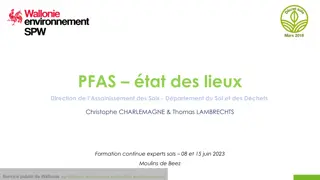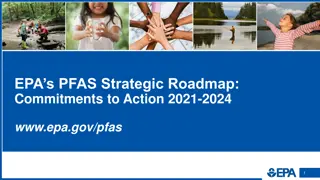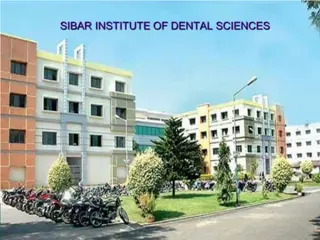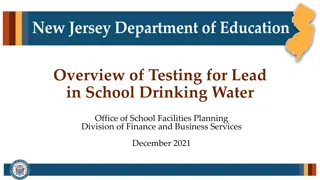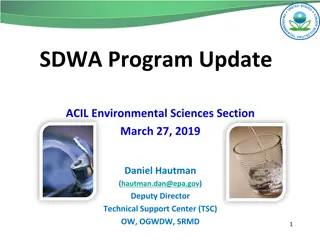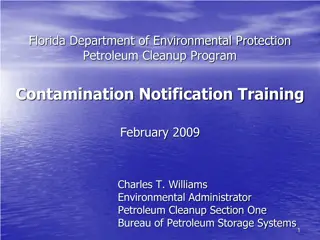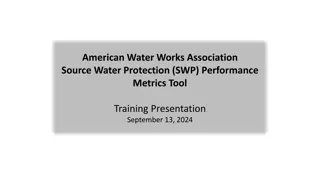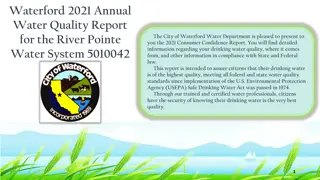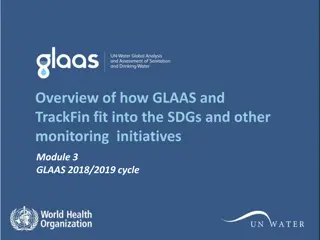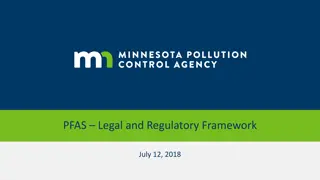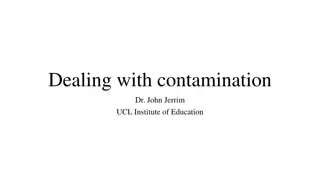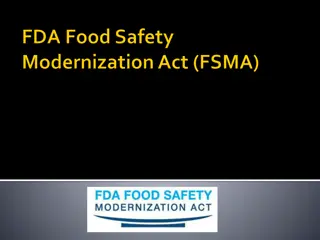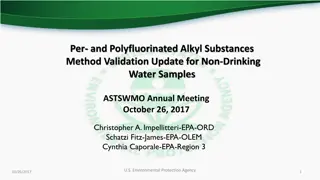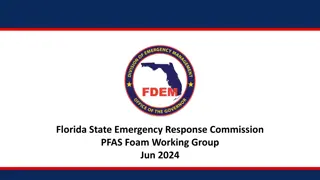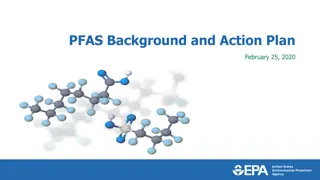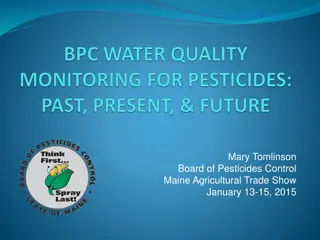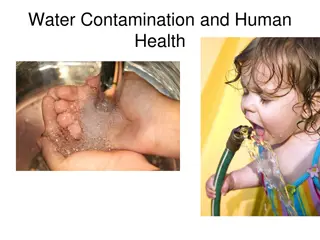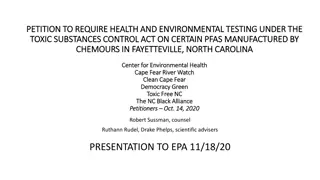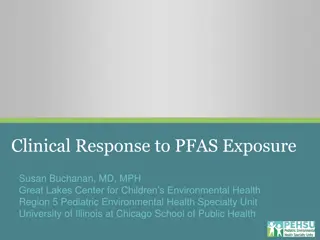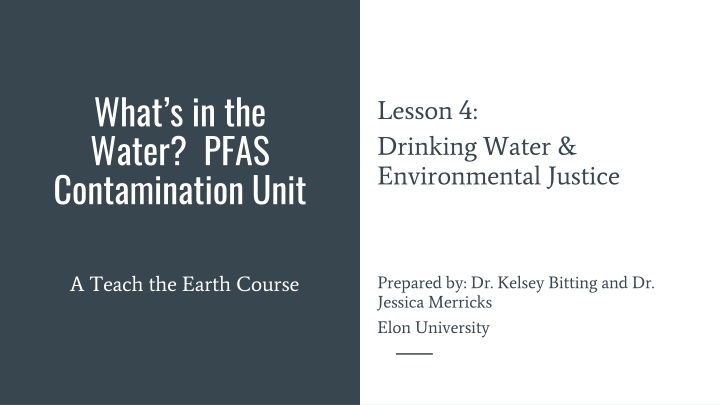
PFAS Contamination: Drinking Water & Environmental Justice
Dive into the complexities of national trends in drinking water access and contamination, exploring the intersection with factors like race, poverty, and demographic disparities. Engage in discussions on clean water violations, costs, and water shutoffs, all while fostering a spirit of curiosity and respectful discourse in understanding environmental justice issues in the U.S.
Download Presentation

Please find below an Image/Link to download the presentation.
The content on the website is provided AS IS for your information and personal use only. It may not be sold, licensed, or shared on other websites without obtaining consent from the author. If you encounter any issues during the download, it is possible that the publisher has removed the file from their server.
You are allowed to download the files provided on this website for personal or commercial use, subject to the condition that they are used lawfully. All files are the property of their respective owners.
The content on the website is provided AS IS for your information and personal use only. It may not be sold, licensed, or shared on other websites without obtaining consent from the author.
E N D
Presentation Transcript
Whats in the Water? PFAS Contamination Unit Lesson 4: Drinking Water & Environmental Justice A Teach the Earth Course Prepared by: Dr. Kelsey Bitting and Dr. Jessica Merricks Elon University
Agenda Small Group Activity: Water Cost & Contamination Trends in the U.S. Discussion: Themes and Causes of Trends Closing Reflection: Connection Points
Community Agreements List here if desired (recommend co-creating these with the students early in the semester and reviewing regularly throughout)
Learning Objectives Explain national trends in drinking water access and contamination and their correspondence with race, poverty, and other demographic factors Explain and critique data visualizations (graphs, charts, figures, etc.) and summarize key ideas from text. Bring a spirit of curiosity to engage in respectful discourse about environmental justice and demographic disparities in the U.S.
Big Picture Questions Where, and for whom, are Clean Water Act violations most frequent and longest in duration? Where, and for whom, is drinking water most expensive? Where, and for whom, are water shutoffs due to past-due bills most common and most quickly imposed?
Small Group Activity- Water Cost & Contamination Trends in the U.S. Discuss your responses to the homework questions Identify the key takeaways from your group s section Create 1 slide that illustrates those key takeaways for the rest of the class Designate a reporter (someone who hasn t reported for your group recently) to share in a 2 2- -3 min ~10 min ~10 min 3 min presentation
Group 1- Americas Secret Water Crisis Executive Summary, Introduction, and pages 3-7 Key points and ideas go here Your group s figure goes here (resize/shape as needed)
Group 2- Americas Secret Water Crisis Executive Summary, Introduction, p. 8-14 Key points and ideas go here Your group s figure goes here (resize/shape as needed)
Group 3- Watered Down Justice Executive Summary, Introduction (pg. 12-17) Key points and ideas go here Your group s figure goes here (resize/shape as needed)
Group 4- Watered Down Justice Drinking Water Contamination and Environmental Justice Communities (18-23) Key points and ideas go here Your group s figure goes here (resize/shape as needed)
Group 5- Watered Down Justice The Safe Drinking Water Act (24-25), Appendix D (45-46) Key points and ideas go here Your group s figure goes here (resize/shape as needed)
Group 6- Watered Down Justice Executive Summary and Divestment in People and Places (26-29) Key points and ideas go here Your group s figure goes here (resize/shape as needed)
Group 7- Watered Down Justice Executive Summary and Recommendations (30-34) Key points and ideas go here Your group s figure goes here (resize/shape as needed)
Group 8- Watered Down Justice Executive Summary and Appendix B & C (42-44) Key points and ideas go here Your group s figure goes here (resize/shape as needed)
Discussion Are drinking water access, cost, and safety equitable in the U.S.? Why or why not? What populations suffer most and least from the burdens of high costs and contamination? How might these trends have come about? What can we do as citizens to shift these trends?
Definitions Implicit bias- ...attitudes or stereotypes that affect our understanding, actions, and decisions in an unconscious manner. These biases, which encompass both favorable and unfavorable assessments, are activated involuntarily and without an individual s awareness or intentional control. - Kirwan Institute for the Study of Race and Ethnicity
Definitions Structural racism- A system in which public policies, institutional practices, cultural representations, and other norms work in various, often reinforcing ways to perpetuate racial group inequity Structural racism is not something that a few people or institutions choose to practice. Instead it has been a feature of the social, economic and political systems in which we all exist. - Aspen Institute
Definitions Environmental justice- the fair treatment and meaningful involvement of all people regardless of race, color, national origin, or income with respect to the development, implementation and enforcement of environmental laws, regulations and policies no group of people should bear a disproportionate share of the negative environmental consequences resulting from industrial, governmental and commercial operations or policies. - U.S. Environmental Protection Agency
Water, Justice, and Pittsboro Pittsboro, NC: Population est. 4,287 In 2010, 72% white, 19% African American, 9% Latino Median household income $35,800 18.3% of population below poverty line Cost of proposed remediation (GAC + IX): $11-13 million (RO: $28-33 million) Cost per resident ~$2800 (family of 4 = $11,200)
Water, Justice, & Pittsboro Pittsboro s Public Works Department is government-run (not private) Recommendations for Pittsboro s board, based on your readings? Other concerns or considerations? Ideas?
Connection points (5 min) How do the water-related environmental justice readings relate to things you re studying or learning about in other classes this semester, or in past semesters? How do they relate to things you ve heard about in the news or from friends or family? To things you ve experienced in your life? How do they relate to your own values? How might your personal or professional goals position you to help reshape these dynamics?

